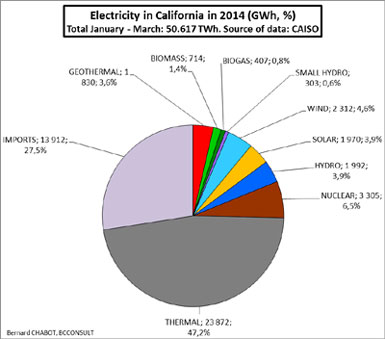Wind energy has passed a threshold in the US – so far this year it’s been supplying 5.15% of our electricity!!!!
And for the first time, renewable energy is contributing more than big hydropower plants – 52.7% vs. 47.3%. When hydro is included, renewable energy provided 14.05% of US electricity this year, which the US Energy Information Administration (EIA) projected we would reach in 2040!
Compared to the first four months of 2013, solar rose 108.9%, wind by 11.5%, and biomass by 4.3%. Geothermal and hydropower both dipped a bit, by 2% and 2.9% respectively. In total, renewable energy grew 4.17% this year, says EIA.
California Shatters Records
All three of the state’s biggest utilities now source over 20% of electricity from renewables and achieving 50% by 2030 is feasible and affordable, according to a report they commissioned by Energy and Environmental Economics (E3).
The state hit a record in March, when utility-scale solar fulfilled 5.1% of its electricity demand – 4.5 GW – supplying 3 million homes. That grows to 17.7% of demand when wind, geothermal and biomass are included, and to 22.4% including hydro, according to the grid operator, California Independent System Operator. And that doesn’t count the 2.2 GW of small, distributed solar, according to BCConsult.

Last June, the state hit its previous record of 2.07 GW, less than half!
Over 134 GW of solar PV is now online worldwide, according to the International Energy Agency – 36.9 GW was added in 2013 across 24 countries. 59% of that is in the Asia Pacific region, 11.3 GW in China alone.
During Q1 of 2014, 9 GW was added worldwide, 35% more than the record-setting Q1 2013. Solar is expected hit records every quarter this year and by the end of Q1 2015, trailing 12-month demand should exceed 50 GW for the first time, says Solarbuzz.
"During the past few years, the solar PV industry has been waiting for end-market demand to catch up with excess manufacturing capacity added between 2010-2012," says Finlay Colville, vice president of Solarbuzz. "This wait is now coming to an end. As annual demand approaches the 50 GW level, suppliers will finally be able to shift their focus from short-term tactical survival to long-term strategic planning."
To reduce levels of carbon in the atmosphere to livable levels, the world needs to generate 28% of electricity from renewables by 2020 and 47% by 2035, says the International Energy Agency.

We need a simultaneous effort directed at energy conservation. The Maglev train, for example, uses a fraction of the electric needed to power a conventional electric train.